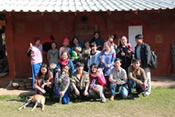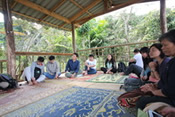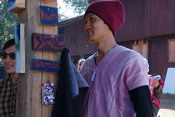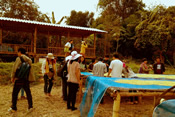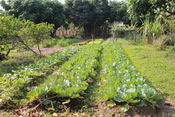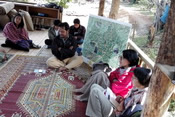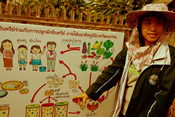
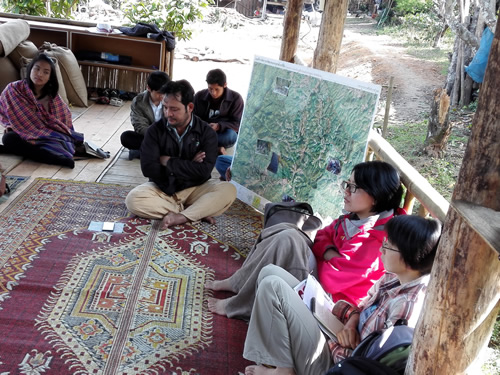 |
| Mae Ta community's in-charge using aerial photos to show the visiting group their forest protection areas. (Wang Weixing) |
By Wang Weixing, Staff of Liang Shuming Rural Reconstruction Centre
|
Editor’s Note(The text is an abridged version edited by PCD.) From the end of January to early February 2015, PCD's Youth Development Team together with members from our partner organisations travelled to Thailand for a 10-day exchange with the Thai Volunteer Service (TVS) and its partner organisations. The objective of the trip was to get to know the young people who had returned to the villages to engage in farming and ecological agriculture, and learn about the experience of these communities in youth development. All these were to be observed in the macro perspective of Thailand's social and NGO development, to give the participants a good opportunity to reflect on Thailand’s situation. At the same time, by visiting the Karen Village, Maewang Village, Mae Ta Village, and the young rural returnees, the visiting team could obtain an initial understanding of the present situation of Thailand's agriculture, the country's rural community development and indigenous cultural conservation; by participating in organic farmers markets, members could understand Thailand's community development and its alternative economic systems. The following is the account of Wang Weixing, one of the participants from the trip, which analyses how Thailand's traditional cultural beliefs and practices of sustainable living let the villagers there respond to the impact of modernisation with confidence. |
“Nowhere in the world has escaped the destruction wrought by this economic system. From the highest mountains to the depths of the oceans, from the deserts to the atmosphere itself, capitalism is destroying the planet. ”
-- Martin Empson, Land and Labor
It was my visits to farms in rural areas during my college days that opened me up to an understanding and critical reflection on agriculture, rural areas and macroscopic changes in society. I asked myself then what kind of life I really wanted? How could I better understand myself and society? Modernisation had burdened society with many unsustainable practices and crises, but there were no structures in place to allow a confident dialogue about this. All this made me feel at a loss and conflicted, though I was still hopeful deep down in my heart.
As I joined in more rural reconstruction endeavours and relevant exchanges, especially during this trip to Thailand, I found that whether at home or overseas, villages are facing a variety of crises brought on by modernisation and globalisation; but at the same time, a large number of reformers are emerging to take on these crises.
A macroscopic view of society and its changes over time have left a series of scorch marks on the lives of individuals, making them feel perplexed and disturbed. This psychological state is rooted in their lack of beliefs or their lack of practical experience, that would otherwise give them confidence. During this trip to Thailand, I witnessed not only the crises brought by globalisation to Thailand's traditional communities or pluralistic agricultural practices, but also their people's long-term exploration for practical ways to deal with these crises, including the practice of ecological agriculture, young rural returnees going back to their home villages to engage in farming, as well as the initiatives of schools of indigenous wisdom. During this trip, I was very moved by a group of persevering and confident practitioners. Their self-confidence lies not only in their revolt against homogeneous modern life, nor in their indigenous beliefs and their in-depth knowledge of traditional wisdom, but more in the sustainable agriculture, culture and community that they have created and promoted through their practices.
Young people embracing confidence as faith
After the car climbed over the mountain ranges, we arrived at Karen tribe's Maewang community. We were received by local indigenous people and young rural returnees, who were living in houses on stilts that they had built and repaired on their own, wearing clothes that they had sewed for themselves. We sat with our legs crossed on the stilt houses over the lake, listening to the core members of the community talking about the efforts they had made to protect their homes and families. They had created maps about community resources, forest coverage, rivers and tributaries; and they had also put forward their demands and negotiated with the government.
The Karen people worship nature and the forests; they are in awe of the flora and fauna of the forests. They worship mountains, rivers, and forests, as they believe these are the dwelling places of gods with enormous power. They also do that because they have depended on the forests for their very survival for generations. They protect the natural forests, and live in harmony with them. Forests are very rich in resources. As modernisation marches on, the government and multinational corporations have started looting forests by turning them into commercial tourist destinations and resorts; at the same time, they have also been mining the forests for ores and minerals, then they have passed the costs of modernisation onto these people in the name of protecting forest resources.
For example, the Thai government has laid down strict regulations governing the protected areas of the forests, requiring corporations to look outside these protected zones for resources, yet during the process of opening up resources in the non-protected zones, quite often the local villagers would also be driven away. Behind the opposition displayed by local villagers against the government are endless miseries and traumas. The villagers bought from universities aerial pictures of their own areas. Through these aerial pictures, it could be seen that the indigenous people often live in the most resource-rich parts of the forests. They planned out on these pictures which parts could be reasonably used for their livelihood and production, and which parts should absolutely be protected; they also organised villagers to put a lot of effort into protecting the forests, then let the government see what they had achieved, such as firebreaks establishment, fire control measures and so on. All these protective measures have won the government's recognition, but not so those measures that deploy the forests' resources rationally for sustaining their livelihood and production. The government often arrests villagers for cutting down trees. When that happens, the management committee jointly formed by 19 villages then steps out and negotiates with the officials.
In the midst of rapid social change, the communities' young people are beginning to evaluate their connection with the outside world as ethnic minorities, and to critically reflect on their own tribes' relationship with the external world: under the looming shadow of modern society pursuing material comforts, would they be able to face the world confidently as Karen people? How about their own relationship with nature? All these questions go right to the core of their hearts and their beliefs.
In a quiet evening, in the open wilderness, we sat with several young people around a bonfire. We overcame the language barrier and felt the energy of nature and of this community. They used their unique clothing, dance, and a language of peace to show us their confidence in their own tribes and to reflect on the problems that modernisation brought to the villages and their everyday lives. They affirmed the beliefs passed down from their ancestors about respecting and revering nature, as well as their own spirituality, which they highly valued as something worth learning. The extent of forest protection and villagers' confidence both corresponded to the number of Karen people living there. The people's faith was not rooted in preaching or sermons, but precipitated from what they had experienced, and had inherited from their ancestors. They were so full of confidence when it came to their own beliefs.
Peasant leaders living out their confidence
Back in the 1960s, globalisation was advancing in Thailand, farms were turning to large scale agricultural production, and fully-fledged monocultural farming was promoted in rural areas; the green revolution was pushing high-yield hybrid crops, together with the extensive use of machinery, fuel, fertilisers, herbicides and pesticides, making Thai farmers increasingly dependent on the market. Ever-increasing production costs, the huge debts borne by farmers, together with health threats, drastically changed Thailand's rural areas.
The community leaders of Maewang village shared the following insights on the current situation, and their criticism towards the Green Revolution: "The more crops a farmer grew, the more debt he would be in, as growing more crops meant more expenditure on fertilisers, pesticides, seeds, fuel, etc; the more industrious these farmers were, the more serious their liabilities would be. Before the Green Revolution, farmers were debt free. Farmers are now constantly consuming, purchasing lifestyle items like cars, motorcycles, mobile phones, color TV sets, refrigerators, clothes, and food. They are spending more and more, but the income from selling rice could only be so much.”
And then, Maewang village began to strive for change. It started promoting ecological agriculture and involved different types of social institutions; soon grassroots communities were changing, and it took them only 3 years to clear their accumulated debts. People doubted initially. However, large-scale mono-cropping really had caused a lot of problems, such as high medical bills to deal with poisoning caused by pesticide spraying. After they persisted in ecological growing for a few years, many of these problems were resolved. Many farmers ' cooperatives and Community Supported Agriculture (CSA) began to spring up. Through the efforts of various parties, farmers and consumers gradually came together to form a sustainable cycle— plant-growing and animal-rearing, production, sales and marketing, food processing, and so on.
This good foundation attracted young people to return to their villages. Parents saw that children with higher education were not enjoying a good life away from their communities, but often striving hard to make ends meet in cities, thus they encouraged their children to come home to help with organic farming. Not only did these parents see no practical use for modern education, they also blamed the academics, who had pushed for a new way of doing agriculture, for the great debts borne by farmers. Mae Ta's farmer leaders even told their children not to continue with postgraduate studies.
After years of striving at the bottom, the farmer-leaders and the villagers saw clearly the harm caused by the Green Revolution; they proved that eco-agriculture is of much greater benefit to their communities, as it lets farmers and nature co-exist in harmony. Eco-agriculture uses well their indigenous knowledge in farming: villagers ferment their own organic fertilisers, brew their own rice wine and hand-make their soaps, etc. They then sell them through urban-rural connection points to gradually complete the system. Farmers could rid themselves of debts through this system, and also avoid poisoning themselves with pesticides, ensuring their physical and mental well-being. This practical experience formed the basis of their confidence, which is the additional fruit of their many years of exploration.


